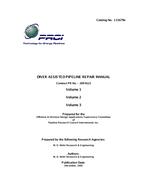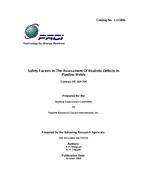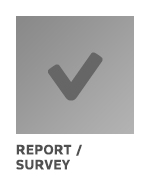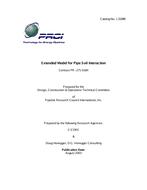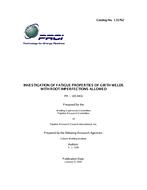Provide PDF Format
PRCI PR-209-9122
- Diver Assisted Repair Manual
- Report / Survey by Pipeline Research Council International, 12/01/1992
- Publisher: PRCI
$325.00$649.00
L51679e
H.O. Mohr Research & Engineering
Need: Much of the industries offshore pipeline system, especially in water depths of 100 ft. or less, is approaching its design life. As this pipeline system ages, the likelihood of a failure due to erosion and/or corrosion in any part of the system is expected to increase. Other factors such as operational errors, vessel related impacts, and environmental phenomenon all contribute to offshore pipeline failures. The basic technology for repairing damaged or failed pipelines offshore has been known for several years. This technology continues to be refined and developed to meet more hostile environments and to improve reliability. At the same time, attempts are being made to minimize the time taken to affect a repair, thereby reducing the downtime of the line and the total cost of the repair.
Result: Three volumes intended to provide the field engineer a guide for the identification and selection of an appropriate diver-assisted repair method for the determination of the required service support, the location of the appropriate repair hardware, and an estimation of the time and cost associated with the repair.
Benefit: The overall set of information is organized into three (3) volumes. The first volume (Volume I) is intended to allow the field engineer to quickly match a pipeline damage condition to one or more repair options. If more than one option is applicable, they are evaluated for the impact of environmental conditions, water depth, line size, and cost, where significant.
The second volume (Volume II) of the manual generically describes the procedures for each of the repair methods and techniques identified in the first volume. These procedures are intended to familiarize the reader with the scope of a particular repair technique or method and are not specific to water depth. Where water depth has a significant affect on the specific procedure, however, it is noted. Volume II also contains the results of the survey of recent repair operations submitted by the member companies. The survey data and information compiled and derived from the analysis of the same is provided as both background or reference information and as a check against the repair procedures generated for this project.
Volume III begins with an alphabetical directory of equipment suppliers and service companies whose hardware, facilities, and expertise, may be required by the field engineer responsible for the repair operation. This directory is followed by specific information on the various repair equipment manufacturers' products. This is useful reference information to be used when comparing competing vendors' hardware or services.
H.O. Mohr Research & Engineering
Need: Much of the industries offshore pipeline system, especially in water depths of 100 ft. or less, is approaching its design life. As this pipeline system ages, the likelihood of a failure due to erosion and/or corrosion in any part of the system is expected to increase. Other factors such as operational errors, vessel related impacts, and environmental phenomenon all contribute to offshore pipeline failures. The basic technology for repairing damaged or failed pipelines offshore has been known for several years. This technology continues to be refined and developed to meet more hostile environments and to improve reliability. At the same time, attempts are being made to minimize the time taken to affect a repair, thereby reducing the downtime of the line and the total cost of the repair.
Result: Three volumes intended to provide the field engineer a guide for the identification and selection of an appropriate diver-assisted repair method for the determination of the required service support, the location of the appropriate repair hardware, and an estimation of the time and cost associated with the repair.
Benefit: The overall set of information is organized into three (3) volumes. The first volume (Volume I) is intended to allow the field engineer to quickly match a pipeline damage condition to one or more repair options. If more than one option is applicable, they are evaluated for the impact of environmental conditions, water depth, line size, and cost, where significant.
The second volume (Volume II) of the manual generically describes the procedures for each of the repair methods and techniques identified in the first volume. These procedures are intended to familiarize the reader with the scope of a particular repair technique or method and are not specific to water depth. Where water depth has a significant affect on the specific procedure, however, it is noted. Volume II also contains the results of the survey of recent repair operations submitted by the member companies. The survey data and information compiled and derived from the analysis of the same is provided as both background or reference information and as a check against the repair procedures generated for this project.
Volume III begins with an alphabetical directory of equipment suppliers and service companies whose hardware, facilities, and expertise, may be required by the field engineer responsible for the repair operation. This directory is followed by specific information on the various repair equipment manufacturers' products. This is useful reference information to be used when comparing competing vendors' hardware or services.
Related Products
PRCI PR-185-9432
Investigation of Fatigue Properties of Girth Welds with Root Imperfections Allowed by API 1104..
$325.00 $649.00

